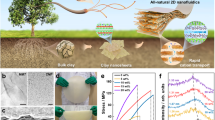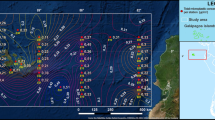Abstract
QUANTITATIVELY, clay minerals are usually the most important components of those fractions of deep-sea sediments which are smaller than 2 µm. There are specific patterns in the distributions of the principal groups of clay minerals in both deep-sea sediments1 and in aeolian dusts from the overlying marine atmosphere2, which have been used to evaluate the origin of the clays. It is considered1–3 that the clay minerals kaolinite, illite and chlorite are largely detrital in origin and are transported to the oceans from the continents.
This is a preview of subscription content, access via your institution
Access options
Subscribe to this journal
Receive 51 print issues and online access
$199.00 per year
only $3.90 per issue
Buy this article
- Purchase on Springer Link
- Instant access to full article PDF
Prices may be subject to local taxes which are calculated during checkout
Similar content being viewed by others
References
Griffin, J. J., Windom, H., and Goldberg, E. D., Deep-Sea Res., 15, 433 (1968).
Chester, R., Elderfield, H., Griffin, J. J., Johnson, L. R., and Padgham, R. C., Mar. Geol., 13, 91 (1972).
Biscaye, P. E., Yale Univ., Geochem. tech. Rep., 8, (1964).
Author information
Authors and Affiliations
Rights and permissions
About this article
Cite this article
CHESTER, R., STONER, J. & JOHNSON, L. Montmorillonite in surface detritus. Nature 249, 335–336 (1974). https://doi.org/10.1038/249335a0
Received:
Issue Date:
DOI: https://doi.org/10.1038/249335a0
Comments
By submitting a comment you agree to abide by our Terms and Community Guidelines. If you find something abusive or that does not comply with our terms or guidelines please flag it as inappropriate.



